#Lays of Beleriand
Photo
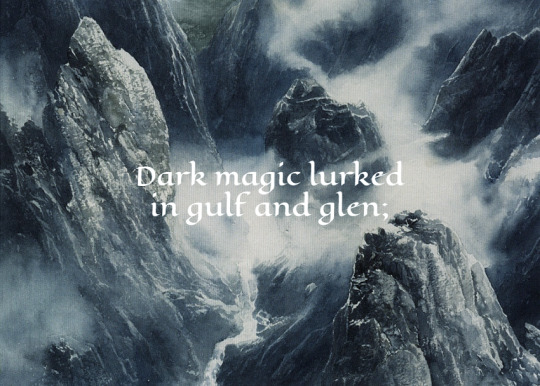
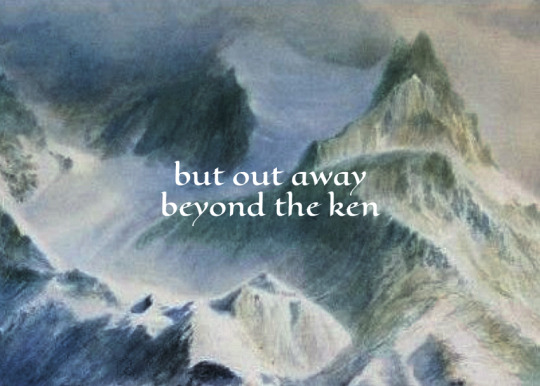



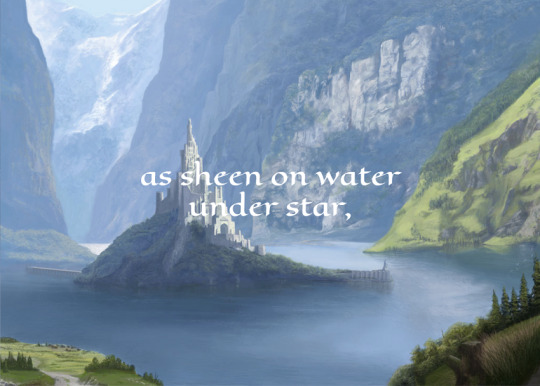


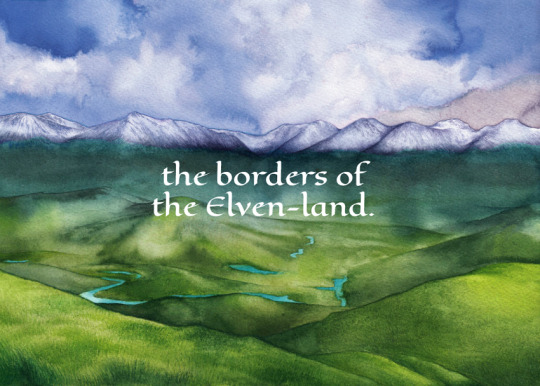
— The Lay of Leithian
Paintings by Alan Lee, John Howe, Stefan Meisl, Ted Nasmith, and Sarka Skorpikova
#lotredit#tolkienedit#silmedit#silmarillion#Lays of Beleriand#my edits#I am once again asking you to read the Lays of Beleriand IT IS SO GOOD
2K notes
·
View notes
Text
There called he longing: '0 Beleg, my brother, 0 Beleg, tell me where is buried thy body in these bitter regions? ' --and the echoes always him answered 'Beleg'; yet a veiled voice vague and distant he caught that called like a cry at night o'er the sea's silence: 'Seek no longer.
My bow is rotten in the barrow ruinous; my grove is burned by grim lightning;
here dread dwelleth, none dare profane this angry earth, Orc nor goblin; none gain the gate of the gloomy forest by this perilous path; pass they may not, yet my life has winged to the long waiting in the halls of the Moon o'er the hills of the sea.
Courage be thy comfort, comrade lonely!
- The Lays of Beleriand, J.R.R. Tolkien
40 notes
·
View notes
Text
really missing the ‘lays of beleriand’ version of the oath where fëanor and sons take it laughing and holding hands….kissing it on the mouth
#and then right after he casually drops that the oath doomed them and is still going 🙃#brought to you by me#every day i wake up + get on my little soapbox#the silmarillion#sad disaster boys (and co.)#the professor's world#lays of beleriand
33 notes
·
View notes
Photo

Ard-galen by Elena Kukanova
From Hithlum’s walls they saw the fire,
the steam and smoke in spire on spire
leap up, till in confusion vast
the stars were choked. And so it passed,
the mighty field, and turned to dust,
to drifting sand and yellow rust,
to thirsty dunes where many bones
lay broken among barren stones.
Dor-na-Fauglith, Land of Thirst,
they after named it, waste accurst,
the raven-haunted roofless grave
of many fair and many brave.
#Silmarillion#Tolkien#Ard galen#Aegnor#Angrod#Elena Kukanova#Quotes#Lays of Beleriand#Dagor Bragollach
373 notes
·
View notes
Text
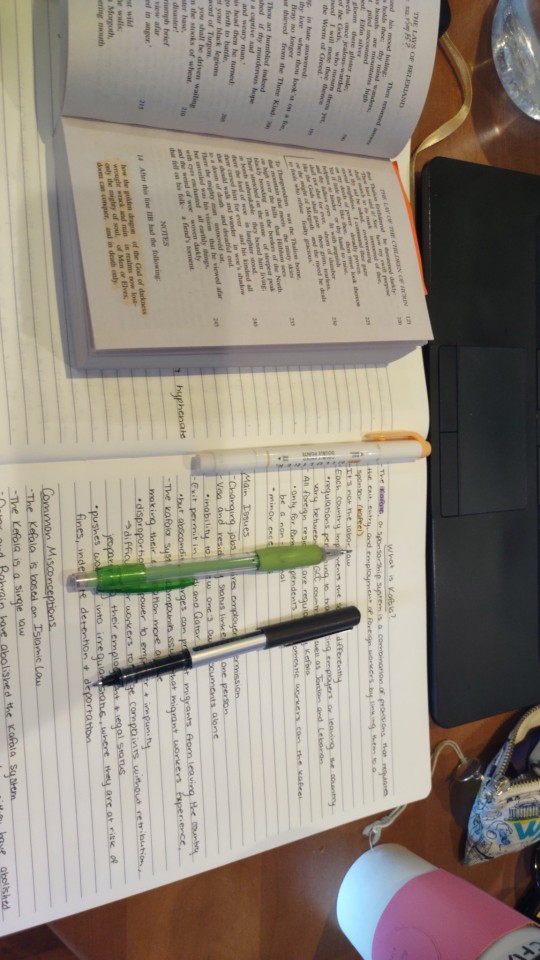

6/3/2023
3 notes
·
View notes
Text



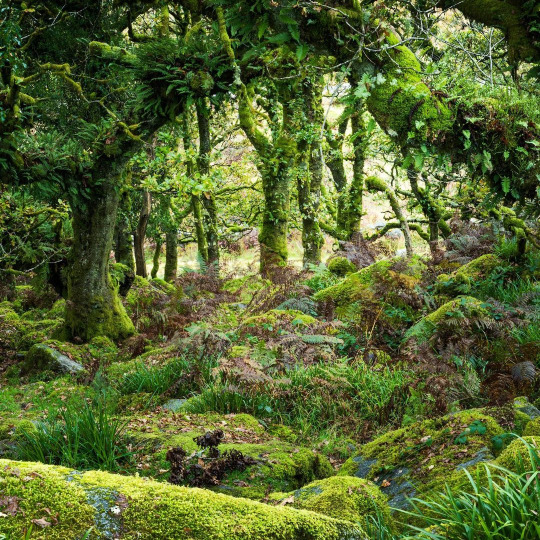

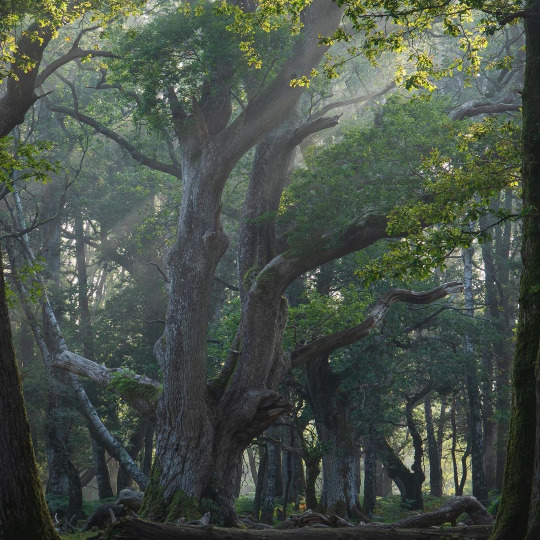

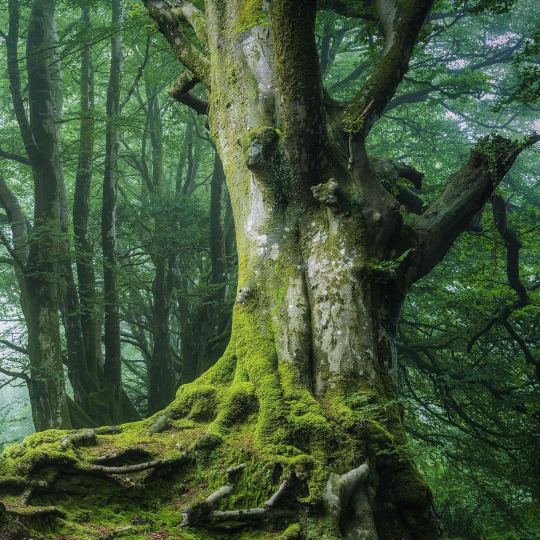

Daeron board for @searchingforserendipity25 wth cave streams, ferns and forests! Seren, you're such a kind person, I reread the tags you leave on my posts all the time and I absolutely adore your writin, especally your dusk piece and your recent Aredhel ones!
x x x x x x x
69 notes
·
View notes
Text
I'm not sure if this has been talked about before, but I'm gonna talk about it regardless because it has completely blown my mind. I first discovered it on a reddit post, which you can read here.
In the book The History of the Hobbit, John Rateliff suggests that the Wilderlands of The Hobbit is actually the Beleriand of Tolkien's early mythology as it was written during the 1930's, only taking place ages after the War of the Jewels, since the later ages and maps of middleearth hadn't been created by Tolkien yet. Keep in mind that at this point in Tolkien's writings, the breaking of Thangorodrim was nowhere near as bad as it would later turn out to be. Beleriand never sank into the sea, but it was still drastically changed.
Here are two maps drawn by Tolkien during the 1930's, one of Beleriand and the other of the Wilderlands found in the Hobbit:
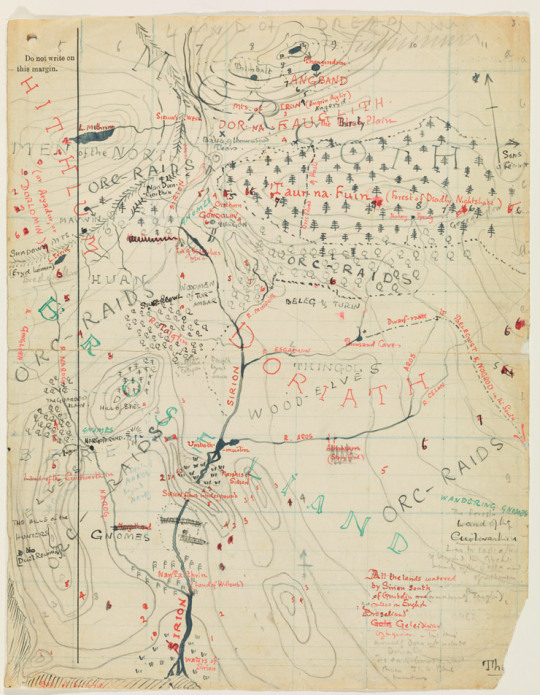

In terms of similarities, one of the first things I noticed(and one of the most obvious) was the river Sirion and the Great River of the Wilderlands. The name Sirion literally translates to 'Great River'.
In the middle of the path of said river is the Carrock, which is where the Eagles set Bilbo and Company down after saving them, and the way it is described in the Hobbit reminds me a lot of this illustration Tolkien made of Tol-Sirion:
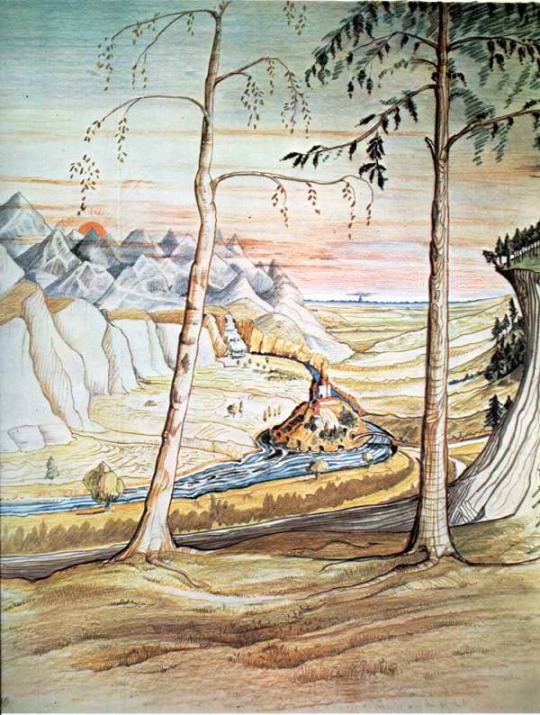
"But cropping out of the ground, right in the path of the stream which looped itself about it, was a great rock, almost a hill of stone, like a last outpost of the distant mountains, or a huge piece cast miles into the plain by some giant among giants."
-The Hobbit, Queer Lodgings.
AND it is also uses very similar wording to how the Lay of Leithian describes Tol-Sirion(Tolkien was working on the Leithian around the same time he was writing The Hobbit):
'An isled hill there stood alone/ amid the valley, like a stone/rolled from the distant mountains vast/when giants in tumult hurtled past'
-Lay of Leithian.
There's also the mention of "a little cave, (a wholesome one with a pebbly floor) at the foot of the steps" which the person in the reddit post suggests could be the remains of the very same dungeon where Finrod, Beren, and their companions were imprisoned by Sauron after their disguises were stripped away. The same place where all but one of them were slowly devoured one by one. The same place where Finrod died.
Above it at the top of the Carrock would be where Finrod was buried, and the "Ford of huge flat stones [that] led to the grass-land beyond the stream" could be the remains of the broken bridge that was destroyed by Luthien: "the hill trembled; the citadel/crumbled and all its towers fell/the rocks yawned and the bridge broke/and Sirion spurned in sudden smoke."
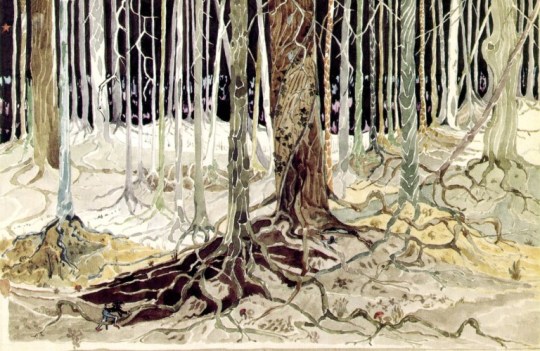
The "two Mirkwoods" is also a big one. I always found it odd that there were two completely different forests sharing the same name, but at the time Tolkien wrote it, they weren't seperate at all, but the exact same forest, just changed and grown over thousands of years in between the events of the Silmarillion and The Hobbit. The same forest that Sauron fled to after the fall of Tol-in-Guarhoth. The same one Beleg found Gwindor in after his escape from Angband.
If they really were intended to be the same forest at the time Tolkien wrote it, it also answers the question I had earlier regarding this part in the Leithian when Sauron flees Tol-in-Guarhoth:

A new stronghold? We never hear anything about this in the Silmarillion, of Sauron building a new stronghold in Taur-nu-fuin, and it puzzled me when I first read it. But that's when I realized that this "new throne and darker stronghold" was talking about none other than the fortress of Dol Guldur itself, Sauron's stronghold within Mirkwood.
(Not lying, I was pretty proud of myself for figuring that one out)
Oh, and the Lonely Mountain? While it doesnt appear on the 1930's Beleriand map, it would likely be Maedhros's fortress of Himring itself, or at least the mountain it was built on top of, as Himring is located east of Taur-nu-fuin just about in the same place where Erebor is located. Just the thought of the Dwarves' home being within the very mountain that once had Maedhros's citadel atop it has my brain going wild. (Oh, and the fact that the arkenstone was found within the ancient hills of what was once Himring, fortress of the elf lord who threw himself into a fiery chasm with a silmaril? Coincidence? I think NOT)
There are plenty of other similar locations between the two maps, and judging by them both Eriador would be Hithlum/Aryador, with the Misty Mountains being the Mountains of Shadow. The Withered Heath would be the Anfauglith, the Eagle Eyrie would be the Crissaegrim, and the Iron Hills are what's left of Nogrod and Belegost. I've even heard that Mavwin/Morwen's house could be the roots of Rivendell.
Overall, it's so, so cool and it has my mind running wild. It really makes me see The Hobbit in a whole new light. We all talk about the amazing stories that came out of the Hobbit aka Lord of the Rings, but seeing where the stories of the Hobbit came from just adds a whole other level of depth to it all. This is why I love Tolkien's works so much. It's all so incredibly deep and rich and it just gets better and richer the deeper you go, and there's so much of it. It's one of those things that you just rarely get tired of, and even if you do, you're bound to come back to it later and I love it.
#Tolkien#Silmarillion#Hobbit#Lay of Leithian#Beleriand#Wilderlands#Lotr#Erebor#Taur-nu-fuin#Mirkwood#Lonely Mountain#Sirion#Finrod#Beren#Luthien#Maedhros#Sauron#Tol-Sirion#Tol-in-Guarhoth
377 notes
·
View notes
Quote
With tears for Finrod weep
repentant! Swords for Morgoth keep!
No kindred blood shall here be shed.
Yet here shall neither rest nor bread
the brethren find who set at naught
Finarfin's house. Let them be sought,
unharmed to stand before me! Go!
The courtesy of Finrod show!
Orodreth sends Celegorm and Curufin from Nargothrond but commands they not be harmed, The Lay of Leithian, J.R.R. Tolkien
141 notes
·
View notes
Text
<- experiencing shrimp emotions (listening to the return of the king ost: battle of the pelennor fields)
#rimi talks#the violin solo does things to me man...#you ever think abt that one throwaway line in yj98 that confirms kon's into lotr#they did that for me specifically.#i know in my heart that while he's primarily in wendy fandom...#kon has definitely written star wars. star trek. and silmarillion fanfic#he's one of those guys making scifi aus about the silm. girdle of melian as a cloaking device. thangorodrim black hole something something.#god fuck i want to watch/read lotr again. and the silm. and home. aakjshguarhgh#wheres my copy of the lays of beleriand i NEED to reread...#<- i experience this literally every time i listen to the lotr ost#lord the horn section before the violin solo. WAILS into my hands
29 notes
·
View notes
Text
"But Finrod walks with Finarfin his father beneath the trees in Eldamar"
I think it's no surprise to my followers who pay attention to my silm posting that I love Finrod Felagund's character, but this is the line that sticks with me heavily. Within the Quenta Silmarillion, it is told that all of those Ñoldor caught within the Doom of Mandos and of the Silmarils will "yearn for [their] bodies, and find little pity", which is often taken to mean that none of those who left Valinor would be granted the possibility of returning to physical form, to live in the bliss of Aman (though arguments can clearly be made that only those who participated in the kinslaying were under such a doom, but I choose to ignore that). That's what makes this line so much more impactful to me, along with a more important facet; it's placement in the chapter.
Just 2 pages earlier, at his death, Finrod says it will be long before he is seen again amongst his people, perhaps believing he will not be granted a bodily form until such a time as the rest of the Ñoldor would be. He dies in the darkness of his corrupted tower, and is mourned at length by Beren until Lúthien his love arrives and rouses him, and together their hope is kindled again as the sun rises (a very common theme in Tolkien's works). They honour and bury Finrod atop the island, a tomb to be unchanged until the War of Wrath caused upheaval in all of Beleriand
It's here that this line comes in. His tomb is inviolate until all the land is, but he himself walks with his father, the only of Finwë's sons to remain in Valinor, and that says so many things.
He is one of few, or perhaps the only, Ñoldorin exile to be gifted bodily rebirth. He surpassed the Doom of Mandos (see my 2nd link in paragraph 1)
His father welcomes him home and forgives his leaving
No matter the state of his grave, Felagund is himself unmarred
No timeline is given for Finrod's bodily resurrection, but I choose to believe it is before the end of the First Age (and the fandom wiki agrees, tolkien gateway being more vague), for no other reason than Eärendil. It is because of Finrod, his assistance of and sacrifice for Beren, that the man of Bëor lives long enough to be united with Lúthien in the Quest, and they, along with Huan, are able to retrieve the Silmaril that Eärendil brings to Aman. I consider that Finrod is likely unaware of the success of the Quest, given it seems the rest of Valinor was (or at least they waited for a plea from Middle-Earth before acting on anything). Imagine his wonder, his pride, and his joy, at seeing that not only was the quest successful, but here, 80 years after he died, he sees Beren and Lúthien's grandson-in-law bearing the jewel. I wonder what he would have said to Amarië his love, if he would have remarked in joyous tears that the horrors and the death that led him back into Aman were not faced in vain. I wonder if, taking up his weapon to participate in the War of Wrath, he either sat a moment in sorrow, or in hope, or in some other emotion, considering what lay ahead of him, and as he came home afterwards with many of his kinsfolk, what he felt as he came to the bliss that would last until the changing of the world.
No matter his feelings on the Wars, what his experiences are and what he goes through after his resurrection, we know this:
Finrod walks with Finarfin his father beneath the trees of Eldamar
#silmarillion#tolkien#finrod felagund#finrod#findarato#findaráto#beren erchamion#beren#luthien tinuviel#luthien#lúthien#finarfin#eärendil#earendil#amarië#one day I will own the lays of beleriand and be even further enamoured with his tale
44 notes
·
View notes
Text
Some of my favorite parts of The Lays of Beleriand
I’m going to copy some of my favorite parts here, but this isn’t all of them, because that would just be the entire book. Still, this will be a long post. No one can stop me. This book is so good and I need to talk about it!
One of the versions of the Lay of the Children of Húrin begins like this:
Lo! the golden dragon of the God of Hell,
the gloom of the woods of the world now gone,
the woes of Men, and weeping of Elves
fading faintly down forest pathways,
is now to tell...
There is just something about the feeling this conveys. The gloom of the woods of the world now gone. That line is so good. It’s like these fragments of epic poems are from a real oral tradition passed down from the First Age, from the world now gone. Don’t get me started on the alliteration. Given who wrote it, I think it’s safe to say the alliterative style of Beowulf was definitely a major influence.
Another version begins:
Ye Gods who girt your guarded realms
with moveless pinnacles, mountains pathless,
o’er shrouded shores sheer uprising
of the Bay of Faery on the borders of the World!
Ye Men unmindful of the mirth of yore,
wars and weeping in the worlds of old,
of Morgoth’s might remembering nought!
Lo! hear what Elves with ancient harps,
lingering forlorn in lands untrodden,
fading faintly down forest pathways,
in shadowy isles on the Shadowy Seas,
sing still in sorrow of the son of Húrin...
I can’t stand how good it is! How this is addressed to the Gods, and then addressed to Men who have forgotten the tales of the First Age. And then it tells you to listen to what Elves still sing in sorrow of the son of Húrin... They remember. They still mourn. There is this sense that even though the Gods have cut themselves off from the world, and Men have forgotten much of the past, there are still those who remember Túrin, and his story is worth telling. It gives me chills.
Here is Húrin in the Nirnaeth Arnoediad, one of my favorite passages:
For Húrin standing storm unheeding,
unbent in battle, with bitter laughter
his axe wielded—as eagle’s wings
the sound of its sweep, swinging deadly;
as livid lightning it leaped and fell,
as toppling trunks of trees riven
his foes had fallen. Thus fought he on,
where blades were blunted and in blood foundered
the Men of Mithrim...
This is so heroic I cannot stand it. I can’t even process it, it’s so good. The alliteration is amazing. The imagery is incredible. That the sound of his axe is like a eagle’s wings recalls the fact that eagles carried him to Gondolin. The comparison to lightning reminds me of another heroic final stand, that of Fingolfin. In this passage there is such a vivid picture of the chaos and violence of the Nirnaeth Arnoediad and how brave Húrin was in this battle. He is a truly great character. And speaking of which, there are several versions of his conversation with Morgoth, and they are incredible!
Said the dread Lord of Hell: ‘Dauntless Húrin,
stout steel-handed, stands before me
yet quick a captive, as a coward might be!
Then knows he my name, or needs be told
what hope he has in the halls of iron?
The bale most bitter, Balrogs’ torment!’
Then Húrin answered, Hithlum's chieftain—
his shining eyes with sheen of fire
in wrath were reddened: ‘O ruinous one,
by fear unfettered I have fought thee long,
nor dread thee now, nor thy demon slaves,
fiends and phantoms, thou foe of Gods!’
His dark tresses, drenched and tangled,
that fell o’er his face he flung backward,
in the eye he looked of the evil Lord—
since that day of dread to dare his glance
has no mortal Man had might of soul.
Is it possible to love Húrin even more? This is just unbelievably good. Morgoth threatens him with torture and that is his reply! Steadfast indeed! I love the way the dialogue is composed and all of the alliteration, which really enhances the intensity of this scene. And I literally cannot convey how stirring this entire section is. It also has a lot of dialogue, which is exciting, since that is something often lacking in the prose Silmarillion.
The Lays of Beleriand also has an early version of the Darkening of Valinor, the flight of the Noldor (the flight of the Noldoli) and the Oath of Fëanor. The entire section is amazing.
The Darkening of Valinor:
A! the Trees of Light, tall and shapely,
gold and silver, more glorious than the sun,
than the moon more magical, o’er the meads of the Gods
their fragrant frith and flowerladen
gardens gleaming, once gladly shone.
In death they are darkened, they drop their leaves
from blackened branches bled by Morgoth
and Ungoliant the grim the Gloomweaver.
In spider’s form despair and shadow
a shuddering fear and shapeless night
she weaves in a web of winding venom
that is black and breathless. Their branched fail,
the light and laughter of their leaves are quenched.
Mirk goes marching, mists of blackness,
through the halls of the Mighty, hushed and empty,
the gates of the Gods are in gloom mantled.
I don’t even know what to say. This is as poignantly and beautifully written as it is painful to read, because the death of the Two Trees is so horrible. In death they are darkened...the light and laughter of their leaves are quenched. There is a sense (as there is elsewhere in Tolkien’s writing) that the Two Trees were not just living things, they were beings that could feel. The fact that they bled (as they also did in The Silmarillion) lends even more horror to this moment. The death of the Trees was not just tragic because they were beautiful and the Gods and the Elves loved their light—it was tragic because they were living things and they suffered. Tolkien never wrote the Aldudénië, the poem lamenting the death of the Two Trees, so I think this is the closest thing we will ever have to what the Aldudénië may have been like (except it would have been in Elvish, of course). Also, I can’t help but notice that Ungoliant is in spider’s form, like in The Silmarillion. It’s easy to forget that she is not a spider, she is in the form of a spider, and that really adds to how mysterious and terrifying she is.
The next lines are amazing too:
Lo! the Elves murmur mourning in anguish,
but no more shall be kindled the mirth of Cor
in the winding ways of their walled city,
towercrowned Tun, whose twinkling lamps
are drowned in darkness...
I love how the imagery of the city is conveyed—winding, walled, towercrowned, twinkling. Tolkien doesn’t interrupt the poem to give a full description of what Tirion looks like, and he doesn’t need to; he hints at it with just a few adjectives in a few lines, and it’s just enough for readers to form a picture.
And here is the Oath of Fëanor:
Then his sons beside him, the seven kinsmen,
crafty Curufin, Celegorm the fair,
Damrod and Diriel and dark Cranthir,
Maglor the mighty, and Maidros tall
(the eldest, whose ardour yet more eager burnt
than his father’s flame, than Fëanor’s wrath;
him fate awaited with fell purpose),
these leapt with laughter their lord beside,
with linked hands there lightly took
the oath unbreakable; blood thereafter
it spilled like a sea and spent the swords
of endless armies, nor hath ended yet:
‘Be he friend or foe or foul offspring
of Morgoth Bauglir, be he mortal dark
that in after days on earth shall dwell,
shall no law nor love nor league of Gods,
no might nor mercy, not moveless fate,
defend him for ever from the fierce vengeance
of the sons of Fëanor, whoso seize or steal
or finding keep the fair enchanted
globes of crystal whose glory dies not,
the Silmarils. We have sworn for ever!’
This is amazing. I have so many thoughts. It’s so interesting that Maedhros is here described as more passionate about the oath, and more full of wrath, than even Fëanor himself. Also, it’s so cool how it speaks of the oath as a present tense thing: nor hath ended yet. And that whole part is so chilling: there lightly took the oath unbreakable; blood thereafter it spilled like a sea... That is terrifying, and such vivid imagery. I love it! It gives me chills every time! And in the oath itself you can really see the origin of the later version which appears in Morgoth’s Ring.
Another favorite passage of mine is this part about the Dagor Bragollach, which is not in alliterative verse like the other parts I’ve quoted, but in rhyming couplets:
Rivers of fire at dead of night
in winter lying cold and white
upon the plain burst forth, and high
the red was mirrored in the sky.
From Hithlum's walls they saw the fire,
the steam and smoke in spire on spire
leap up, till in confusion vast
the stars were choked. And so it passed,
the mighty field, and turned to dust,
to drifting sand and yellow rust,
to thirsty dunes where many bones
lay broken among barren stones.
Dor-na-Fauglith, Land of Thirst,
they after named it, waste accurst,
the raven-haunted roofless grave
of many fair and many brave.
Those last two lines are so haunting. There’s something about the way this is written, what it says and doesn’t say. It doesn’t describe the fighting itself, just the beginning of the battle and the aftermath. And there are descriptions of the sky and the field and how it turned to dust before it tells you of the many bones of the dead, and then hits you with those last two lines, which are just brutal. It’s so tragic. When I read this I want to ride to Angband and challenge Morgoth to single combat myself. I can understand why Fingolfin felt such wrath and despair.
Speaking of which, The Lays of Beleriand also has a version of Fingolfin’s challenge to Morgoth, and it is so good! This is just the beginning of it:
In that vast shadow once of yore
Fingolfin stood: his shield he bore
with field of heaven’s blue and star
of crystal shining pale afar.
In overmastering wrath and hate
desperate he smote upon that gate,
the Gnomish king, there standing lone,
while endless fortresses of stone
engulfed the thin clear ringing keen
of silver horn on baldric green.
His hopeless challenge dauntless cried
Fingolfin there: ‘Come, open wide,
dark king, your ghastly brazen doors!
Come forth, whom earth and heaven abhors!
Come forth, O monstrous craven lord,
and fight with thine own hand and sword,
thou wielder of hosts of banded thralls,
thou tyrant leaguered with strong walls,
thou foe of Gods and elvish race!
I wait thee here. Come! Show thy face!’
This is...YES. I love this so much! I’m so overjoyed that Tolkien wrote it! The Silmarillion doesn’t tell us Fingolfin’s actual words to Morgoth when he called him forth to single combat, only that he named him craven, and lord of slaves. This is Fingolfin’s actual challenge, or a poetic retelling of it at least. This is larger than life. And the entire rest of this section is just as good. It describes the fight itself, and how Thorondor rescued Fingolfin’s body and bore it away to the mountains above Gondolin. And it is full of incredible descriptions and absolutely awe-inspiring lines. I will never recover from the sheer epicness of the line at the end of the section which reads, till Gondolin’s appointed doom.
Another of my favorite parts is this passage about the halls of Menegroth:
Then sudden, deep beneath the earth
the silences with silver mirth
were shaken and the rocks were ringing,
the birds of Melian were singing;
and wide the ways of shadow spread
as into arched halls she led
Beren in wonder. There a light
like day immortal and like night
of stars unclouded, shone and gleamed.
A vault of topless trees it seemed,
whose trunks of carven stone there stood
like towers of an enchanted wood
in magic fast for ever bound,
bearing a roof whose branches wound
in endless tracery of green
lit by some leaf-emprisoned sheen
of moon and sun, and wrought of gems,
and each leaf hung on golden stems.
Lo! there amid immortal flowers
the nightingales in shining bowers
sang o’er the head of Melian,
while water for ever dripped and ran
from fountains in the rocky floor.
There Thingol sat. His crown he wore
of green and silver, and round his chair
a host in gleaming armour fair.
I mean this is just unbelievably beautiful! It’s gorgeous! The descriptions are so vivid! I want to go there! It’s also the most detailed description of Menegroth that exists, which makes me wonder what other details we might have gotten if Tolkien hadn’t abandoned the poetic Silmarillion.
Another part that never fails to give me chills is this, when Beren departs from Dorthonion:
Southward he turned, and south away
his long and lonely journey lay,
while ever loomed before his path
the dreadful peaks of Gorgorath.
Never had foot of man most bold
yet trod those mountains steep and cold,
nor climbed upon their sudden brink,
whence, sickened, eyes must turn and shrink
to see their southward cliffs fall sheer
in rocky pinnacle and pier
down into shadows that were laid
before the sun and moon were made.
In valleys woven with deceit
and washed with waters bitter-sweet
dark magic lurked in gulf and glen;
but out away beyond the ken
of mortal sight the eagle’s eye
from dizzy towers that pierced the sky
might grey and gleaming see afar,
as sheen on water under star,
Beleriand, Beleriand,
the borders of the Elven-land.
Chills! Chills every time! First of all, shadows that were laid before the sun and moon were made is a terrifying concept and I love it so much. And second of all, Beleriand, Beleriand, the borders of the Elven-land! I love the way the momentum builds as the poem continues, and the sense of longing that those last lines convey... it gets me every time.
I don’t know what the point of this post is except to say I love The Lays of Beleriand so much! I could have made this post twice as long. Or three times as long. There are so many incredible parts of it. I just love this book and I wish it got more attention. I think when some people try reading HoMe they give up somewhere in the Lost Tales and never make it to The Lays of Beleriand, which is a tragedy. If you haven’t, please read The Lays of Beleriand!
193 notes
·
View notes
Text
#lotr#jrr tolkien#lotr books#lord of the rings#the silmarillion#first age#tolkien legendarium#doriath#beleriand#melian#luthien tinuviel#beren and luthien#elu thingol#elwe singollo#tolkien elves#maiar#thingol#luthien#lay of leithian#beren x luthien#lotr poll
9 notes
·
View notes
Text
WAIT I’ve just realised that the absolute first thing we read about Maglor in the Silm book is that he was a “mighty singer, whose voice was heard far over land and sea”!! The character defined by his role as “the follower,” whose final most significant choice at the end leads to inaction and yielding to Maedhros and suffering for it, whose most notable deed was that of fostering Elrond and Elros, who never became as much of an influential figure himself, who eventually faded away into exile and insubstantial legend, whose voice was heard far… I can’t do it. It’s been far too long since I’ve had pain this excellent from canon.
#his epithet was `the mighty` in the scrapped poem in lays of beleriand as well iirc#that feeling when the guy who’s hinted at to be powerful ends up passive and not making much of a difference in the end!#that feeling when that same guy—who always acts too little too late—takes in and raises the twins who create kingdoms and sanctuaries#and change history forever! the ones whose voices & decisions change the world andare heard far over land and sea!!#that feeling is Agony. Torment perhaps.#maglor#silmarillion
180 notes
·
View notes
Note
For the Choose Violence ask game: 22 for any of Tolkien's Middle Earth works? (Histories of Middle Earth included.)
Two asks for this one!
@nopewood: 22 for the ask game pleaseee ^^
22. your favorite part of canon that everyone else ignores
It's not entirely ignored, but the poetic Leithian deserves way higher profile than it has! It's absolutely magnificent as poetry and also elaborates a lot more of the events of Beren and Lúthien's Quest than the text of the Silmarillion does (for example: the spell Lúthien uses to grow her hair is incredibly complex, cool, and rather spooky).
Another part that I really like that almost everyone ignores is "The Coming of Tuor to Gondolin" in Unfinished Tales. I love the characterization that we get of Tuor during his time as a outlaw and his journey to Nevrast and thence to Gondolin - he, well 'chill' compared to the other Edain we get, but he's not entirely chill and it's really not sufficiently recognized that he waged a single-handed guerilla war in Hithlum for about three years when he was little more than a teenager.
A specific bit of that that I like and that no one else seems (understandably!) to care about is the description of the gates of Gondolin. I love it. The imagery of the different materials, colours, the structure, the designs and what they symbolize/convey. And we're also told that the Elves created a lot of magnificent things, but they're rarely described in detail, and we get such great descriptions here.
Gates!
Thus they came at length to a wide art with tall pillars upon either hand, hewn in the rock, and between hung a great portcullis of crossed wooden bars, marvellously carved and studded with nails of iron. Elemmakil touched it, and it rose silently, and they passed through.
"You have passed the First Gate, the Gate of Wood," said Elemmakil.
...Some half-league from the Wooden Gate Tuor saw that the way was barred by a great wall built across the ravine form side to side, with stout towers of stone at either hand. In the wall was a great archway above the road, but it seemed that masons has blocked it with a single mighty stone. As they drew near its dark and polished face gleamed in the light of a white lamp that hung above the midst of the arch.
"Here stands the Second Gate, the Gate of Stone," said Elemmakil; and going up to it he thrust lightly upon it. It turned upon an unseen pivot, until its edge was towards them, and the way was open upon either side; and they passed through, into a court where stood many armed guards clad in grey.
...After a little space they came to a wall yet higher and stronger than before, and in it was set the Third Gate, the Gate of Bronze: a great twofold door hung with shields and plates of bronze, wherein were wrought many figures and strange signs. Upon the wall above its lintel were three square towers, roofed and clad with copper that by some device of smith-craft were ever bright and gleamed as fire in the rays of the red lamps ranged like torches against the wall. Again silently they passed the gate, and saw in the court beyond a yet greater company of guards in mail that glowed like dull fire; and the blades of their axes were red. Of the kindred of the Sindar of Nevrast for the most part were those that held this gate. [NOTE: Another reference to the Sindar using axes as their main weapon, something that I almost never see in fic.]
....Thus at last they drew near the Fourth Gate, the Gate of Writhen Iron. High and black was the wall, and lit with no lamps. Four towers of iron stood upon it, and between the two inner towers was set an image of a great eagle wrought in iron, even the likeness of King Thorondor himself, as he would alight upon a mountain from the high airs. But as Tuor stood before the gate it seemed to his wonder that he was looking through boughs and stems of imperishable trees into a pale glade of the Moon. For a light came through the traceries of the gate, which were wrought and hammered into the shapes of trees with writhing roots and woven branches laden with leaves and flowers and as he passed through he saw how this could be; for the wall was of great thickness, and there was not one grill but three in line, so that to one who approached in the middle of the way each formed part of the device; but the light beyond was the light of day...Now they passed through the lines of the Iron Guards that stood behind the Gate; black were their mantles and their mail and long shields, and their faces were masked with vizors each bearing an eagle's beak.
What the Fourth Gate reminds me of at the moment is Menegroth - trees carved in iron, as Menegroth is trees and birds and other animals wrought in stone, the combination of the love of nature with the love of craft through the work of two different peoples. And the sequence - the different materials (wood, stone, bronze, iron), the number of towers matching the number of the gates, the guards outfitted in a way that matches the gates - really appeals to me. The connection of Gondolin both with Ulmo, who showed Turgon the location and concealed his people so they could get here, and with Manwë via Thorondor (who is really Turgon's link to the outside world, and brings him news on more than one occasion) is just fantastic.
Then we have the gates of Silver and Gold:
Tuor saw beside the way a sward of grass, where like stars bloomed the white flowers of uilos, the Evermind that knows no season and withers not; and thus in wonder and lightening of heart he was brought to the Gate of Silver.
The wall of the Fifth Gate was built of white marble, and was low and broad, and its parapet was a trellis of silver between five great globes of marble; and there stood many archers robed in white. The gate was in shape as three parts of a circle, and wrought of silver and pearl of Nevrast in likenesses of the Moon; but above the Gate upon the midmost globe stood an image of the White Tree Telperion, wrought of silver and malachite, with flowers made of great pearls of Balar. And beyond the Gate in a wide court paved with marble, green and white, stood archers in silver mail and white-crested helms, a hundred upon either hand. Then Elemmakil led Tuor and Voronwë through their silent ranks, and they entered upon a long white road, that ran straight towards the Sixth Gate; and as they went the grass-sward became wider, and among the white stars of uilos there opened many small flowers like eyes of gold.
So they came to the Golden Gate, the last of the ancient gates of Turgon that were wrought before the Nirnaeth; and it was much like the Gate of Silver, save that the wall was built of yellow marble, and the globes and parapets were of red gold; and there were six globes, and in the midst upon a golden pyramid was set an image of Laurelin, the Tree of the Sun, with flowers wrought of topaz in long clusters upon chains of gold. And the Gate itself was adorned with discs of gold, many-rayed, in likenesses of the Sun, set amid devices of garnet and topaz and yellow diamonds. In the court beyond were arrayed three hundred archers with long bows, and their mail was gilded, and tall golden plumes rose from their helmets; and their great round shields were red as flame.
As I reread this...I had thought before of Gondolin, the image of Tirion in Valinor, being a symbol/indication of Turgon's inability to let go of his homesickness, and the images of the Trees being connected to that. But it doesn't feel like that now - it feels like a fusion, of the past in Valinor (the two Trees) and present in Beleriand (the Moon and Sun, and also the pearls of Nevrast and Balar; the latter indicate that Turgon must also have had a close relationship with Cirdan and the Falathrim) - and by the way, how did Turgon realize the connection between the Trees and the moon and sun, when as far as the Noldor know the Trees were entirely dead? It's an impressive connection to work out by himself.
These gates - and their matching flowers, which is an amazing touch - are more decorative and less military than the others, as though, having passed the gate of iron, the focus is now more on beauty rather than defence. And then we're slapped in the face with this:
The way was short to the Seven Gate, named the Great, the Gate of Steel that Maeglin wrought after the return from the Nirnaeth, across the wide entrance to the Orfalch Echor. No wall stood there, but on either hand were two round towers of great height, many-windowed, tapering in seven storeys to a turret of bright steel, and between the towers there stood a mighty fence of steel that rusted not, but glittered cold and white. Seven great pillars of steel there were, tall with the height and girth of strong young trees, but ending in a bitter spike that rose to the sharpness of a needle; and between the pillars were seven cross-bars of steel, and in each space seven times seven rods of steel upright, with heads like the broad blades of spears. But in the centre, upon the midmost pillar and the greatest, was raised a mighty image of the king-helm of Turgon, the Crown of the Hidden Kingdom, set about with diamonds.
This is grim and forbidding and hostile after the Gates of Silver and Gold - like passing from an intricately carved gate of a garden to a fence of razor wire. It's the only gate that Elemmakil can't open for them, and there's no elegant way to knock - you just have to bang on the bars. The pillars of steel might be the size of young trees, but they aren't carved to look like trees or anything else - they're just spikes. The other gates had images of nature, and sometimes of the world outside; this gate is hostile to the world outside.
And, after the three previous gates with Thorondor followed by the images of the creations of Valar - the Trees and the Moon and Sun - we have an image of Turgon's crown on this one.
This is a very clear warning to the reader - something is wrong in Gondolin. Turgon has grown proud and shut out the outside world, and is putting himself and his desires as of the foremost importance. This Gate tells us what Turgon's answer to Tuor's message from Ulmo will be even before Tuor delivers us. And the statement that Maeglin made this gate shows him symbolically as an influence upon this change of attitude in Turgon. Everything about this gate foreshadows the fall of Gondolin.
Thank you for indulging me on this super long post! Look, I just really enjoy imagery and patterns!
#tolkien#the silmarillion#unfinished tales#gondolin#the fall of gondolin#turgon#the lays of beleriand#history of middle-earth#beren and luthien#ask game
30 notes
·
View notes
Quote
Then his sons beside him...there lightly took
the oath unbreakable; blood thereafter
it spilled like a sea and spent the swords
of endless armies, nor hath ended yet:
‘Be he friend or foe or foul offspring
of Morgoth Bauglir, be he mortal dark
that in after days on earth shall dwell,
shall no law nor love nor league of Gods,
no might nor mercy, not moveless fate,
defend him for ever from the fierce vengeance
of the sons of Fëanor, whoso seize or steal
or finding keep the fair enchanted
globes of crystal whose glory dies not,
the Silmarils. We have sworn for ever!’
The Flight of the Noldoli
119 notes
·
View notes
Text
And thus in anguish Beren paid
for that great doom upon him laid,
the deathless love of Lúthien,
too fair for love of mortal Men;
and in his doom was Lúthien snared,
the deathless in his dying shared;
and Fate them forged a binding chain
of living love and mortal pain.
— The Lays of Beleriand, "The Doom of Lúthien"
J.R.R. Tolkien
#The Lays of Beleriand#The Doom of Luthien#Luthien#Beren#beren and luthien#luthien tinuviel#Daughter of Flowers#Beren Erchamion#love#mortality#lord of the rings#lotr#j.r.r. tolkien#tolkien#poem#source embedded#random
8 notes
·
View notes